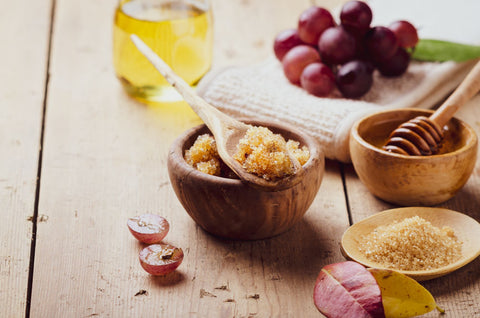What's The Best Exfoliator For Sensitive Skin?
If you have rosacea, acne or sensitive skin of any kind you're probably wondering what is the best exfoliator for sensitive skin, or whether ypu should even exfoliate.
You know that it’s important to clear your skin of dead and dying cells and debris, and to unclog pores to restore good skin health - but exfoliating can be too harsh for sensitive skin, doing more damage than good.
In this article we’ll take a look at –
- Why exfoliate sensitive facial skin
- Exfoliates for sensitive skin
- Does exfoliating with sugar and honey work?
- Yoghurt – all in one cleanser and exfoliant?
- Combining Exfoliation & Nourishment For Sensitive Skin
Why Exfoliate Sensitive Facial Skin
The skin has multiple layers – some say 10, some say 7, 5 or even 3. It depends on how closely you want to look at it. For the sake of simplicity we’ll look at it from the perspective of three.

At the base are basal cells (subcutaneous level), then dermal cells, and the horny layer on the outside/surface of the skin is called the epidermis. The food we eat starts forming our skin cells at the basal level.
The skin cells grow and evolve, as they go up through the layers until they become the horny layer which protects us.
The skin cells are a little bit like scales on the skin. As they come to the top of the surface they flatten and combine with the oil and sweat on our skin – the excretions from the sebaceous and sudiferous glands. The flattened platelet type skin cells protect our body.
They can be a little bit like hair follicles too, and they can lift a bit. They naturally grow and over about 30-40 days depending on your skin type and your age, those skin cells are continually replenished and replaced.
Dead and dying cells can become scaly. And this can be exaggerated and accelerated when you wear makeup. Especially if you use makeup which contains alcohol or other dehydrators such as petrolatums as these dehydrate your skin, and make the skin cells die off faster and become more flaky.
If you don’t remove these dead and dying cells and debris, your facial skin may appear dull, and will not feel smooth, or have an even texture. This debris can also act as a barrier stopping skin products from penetrating and nourishing your skin, and ultimately reduce your ability to create the best healthy new skin cells.
This will increase the appearance of fine lines and wrinkles, and prevent your skin from strengthening and becoming more supple and elastic. And let’s face it – when you have sensitive skin – skin strengthening is an even bigger deal and more important than normal.
So, yes, in today's world, we need to remove those dead and dying cells – but when we have sensitive skin we need to be especially careful with how we do this.
Best Exfoliator For Sensitive Skin
The main types of exfoliators are physical and chemical exfoliators such as the alpha hydroxy acids like salicylic acid, lactic acid, RetinA and vitamin A.
They all work in different ways to slough off the top layer of skin. But we don’t want to slough it off too much.
A lot of people have used physical, grainy exfoliators with things like walnut kernel – but these are not good for skin and should be avoided. When you look under a microscope, things like walnut kernels are really spikey and they can damage the skin.
Options like alpha hydroxy acids and chemical type exfoliators can really sensitise the skin. They have their place, but for people with sensitive skin they can cause problems.
Other exfoliators like those using New Zealand halloysite clay simply absorb dead and dying cells and toxins on the skin without causing damage or increasing skin sensitivity. The clay works like a molecular sieve. It’s selective about what debris it removes. And it doesn’t remove all the oils from your skin that your skin actually needs.
Does Exfoliating With Sugar And Honey Work?
You may be wondering if exfoliating with sugar works, and how to exfoliate with sugar?
The simple answer is - yes - it does work. This is one of the few good places to use sugar – as an exfoliator on the skin.

But, if you are going to use sugar as an exfoliant – use brown sugar instead of white sugar. It’s not as sharp. Mix the brown sugar with a little honey, and a tiny little bit of water. Pop that mixture on your face and just gently massage it – don’t scrub it – into your skin.
Don’t ever vigorously rub your skin. It’s not good for it – especially if you suffer from acne, rosacea, or acne rosacea – or have sensitive skin of any kind. This will aggravate your symptoms of rosacea or acne, and damage the small capillaries on the top of the skin.
If you’re going to use something like brown sugar and honey as an exfoliator, just put it on the skin, leave it there for a few minutes, and give it a really gentle massage.
BUT - I personally wouldn’t use brown sugar etc on my face, or suggest you use it on yours if you have sensitive skin - but it’s a really good body exfoliator. The epidermis is much thinner on your face. That explains why we wrinkle more on our face, and more prone to dilated capillaries.
And it’s why I prefer and recommend to use only very gentle exfoliators on the face.
Yoghurt – All In One Cleanser And Exfoliant
I really like to use natural unsweetened yoghurt on the face as a cleanser and exfoliator (see how to cleanse your face properly). The lactic acid in those natural milk sugars are a very gentle exfoliator, especially if you double cleanse.
And you’ll feel it.
Massage the yoghurt into your skin, rinse with tepid water, and then do it again.
You’ll feel the skin layers around the nose in particular rubbing off. It’s a really great way to exfoliate on a daily basis in a very gentle and effective way.
A cleanser with a small amount of lactic acid, like natural unsweetened yoghurt is incredibly gentle on your skin. You don’t get that build-up of flaky skin or debris so you’re always left with a smooth texture. Natural unsweetened yoghurt is also incredibly hydrating.
I recommend double cleansing with natural unsweetened yoghurt once per day, in the evening, as this will remove EMFs and urban pollution from the day, and best prepare your skin to heal and restore as your sleep.
Using natural unsweetened yoghurt as a cleanser and exfoliant provides a solid foundation for skin health, and avoiding further skin damage.
But if you’re serious about strengthening and repairing your skin as well, it would pay to consider going the extra distance with a New Zealand halloysite clay and bee venom mask, and additional nourishment and nutrition for your skin.
Combining Exfoliating With Nourishment For Sensitive Skin
Using a New Zealand halloysite clay and bee venom mask 2-3 times per week will take your skin care to whole new level. It'll go the extra distance when it comes to removing toxins and debris, balancing the natural oils in your skin, and boosting the production of healthy new skin cells.
Before I started producing skincare and became internationally renowned as a natural skincare scientist, I used to run the lab in a mine in New Zealand that produced that clay.
There’s no other clay like it in the world. It has a rod like structure, and when we treat it with the heat that we treat it with before we put it in the product, it actually draws toxins out of the skin naturally (without scrubbing) – very specifically.
And when the halloysite clay is combined with potent natural ingredients such as bee venom and manuka honey it not only exfoliates gently, it also feeds your skin, provides super hydration, and tricks your body into producing more collagen and healthy skin cells.
This is what the Power Super Mask has been specifically designed for. It’s like a combined exfoliant and superfood for your skin. Perfect for anybody with sensitive skin, who wants healthier, stronger, glowing skin. It exfoliates and stimulates fresh skin layers, allowing more robust skin layers to develop.
The bee venom is worth a special mention. In this scientific research (cited here) bee venom has been proven to be an extremely effective skin treatment for boosting collagen production, skin repair, and anti-aging. The Power Super Mask is especially potent containing 11 times more bee venom – while being an extremely gentle exfoliator for sensitive skin at the same time.

Summary – How To Exfoliate Sensitive Facial Skin
If you have sensitive skin you really do need to pay attention to removing dead and dying skin cells, and preparing your skin to receive good nourishment and hydration – and stimulate the production of healthy new cells.
I recommend:
- Do not over-cleanse or use harsh exfoliating practices (such as scrubbing) or physical exfoliating products with grains and kernels in them.
- A brown sugar and honey exfoliant is fine for your body, but it’s best not to use this on your face.
- Use natural unsweetened yoghurt, double cleansing once per day in the evening. It will act as both an exfoliant and a cleanser.
- Give your skin a boost 2-3 times per week with a product such as the Power Super Mask which contains halloysite clay, bee venom, manuka honey plus many more active natural ingredients which promote soothing, healing and rejuvenation of facial skin.
By Suzanne Hall - Internationally Acclaimed Natural Skincare Scientist and winner of 28 international awards. About Suzanne Hall
Did You Find This Article Helpful?
You may also enjoy -
What's The Best Skincare Routine & Treatment For Rosacea & Acne Rosacea?
How To Cleanse Your Face Properly - Rosacea | Acne | Anti-aging
Can Bee Venom Really Build Collagen?
Beautiful Bees And Their Amazing Gifts To Us
Do you have a question about your skin or skincare? - write to us on potentnature@powerskinsolutions.com, or add a comment below.

